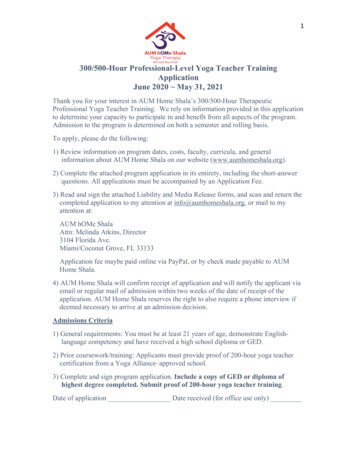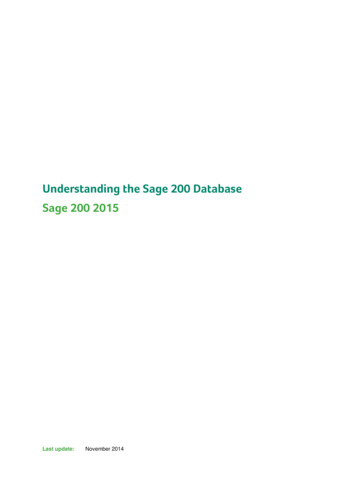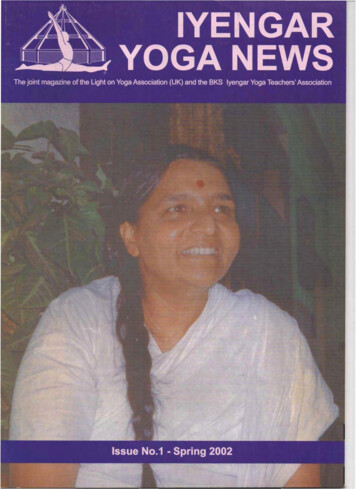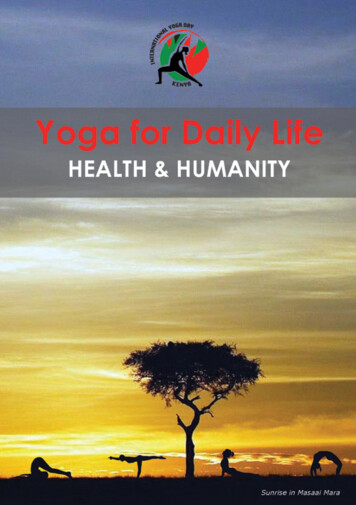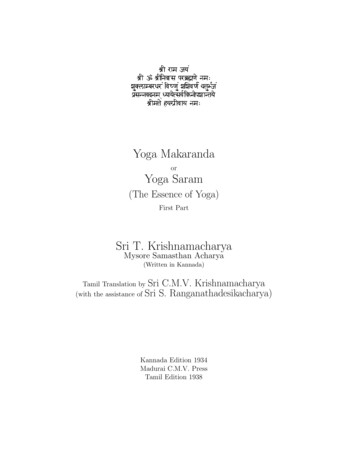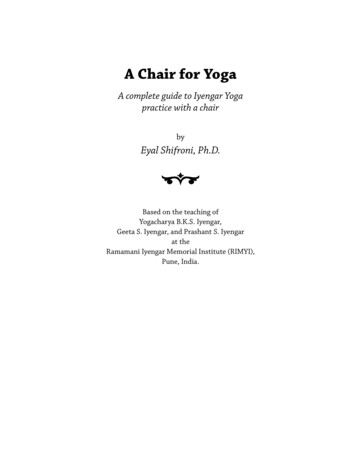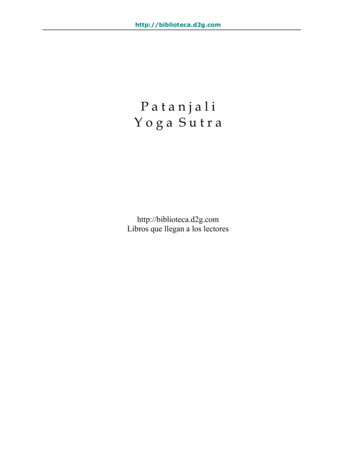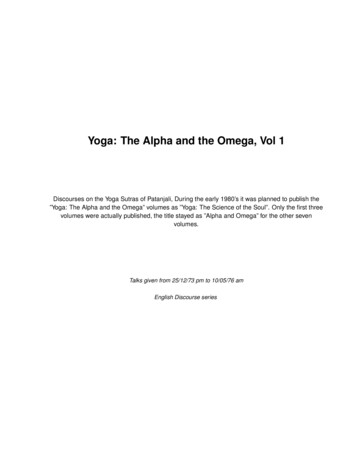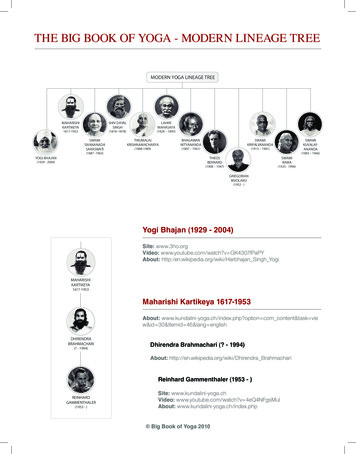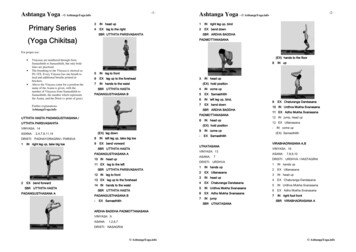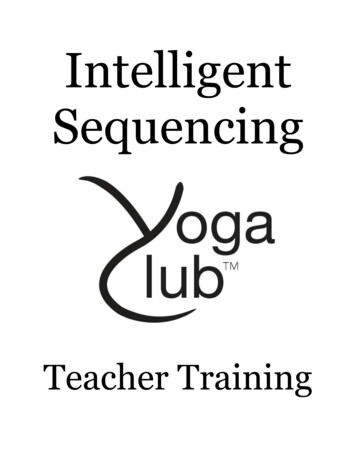
Transcription
IntelligentSequencingTeacher Training
Yoga Club Teacher Training Manual Parallel Yoga PosesTable of ContentsTable of Contents . 2Section 1. 3Objectives . 3Definition . 3Purpose. 3Considerations for Sequencing . 4Basic Sequence Format . 4General Physical Principles of Sequencing: . 6Section 2 Ashtanga Yoga . 8Section 3 Baptiste Power Yoga . 10Section 4 Bikram Yoga . 17Section 5 Tools for Sequencing . 22Section 6 Types of Sequencing. 29Section 7 Creating A Theme For Practice . 40www.yogaclub.usPage 2
Yoga Club Teacher Training Intelligent SequencingThe Art of Intelligent SequencingSection 1Objectives1. Understand how to prepare students both anatomically and systematically for theflow of your class.2. Explore the sequences of many popular styles of yoga including Ashtanga,Baptiste Power Yoga, and Bikram Yoga.3. Understand the rational and benefits of these styles and sequences.4. Learn to use this information to intuitively create our own organic,transformative, multi-dimensional yoga flow.5. Learn to build classes around peak poses, chakras, philosophical themes, acategory of asana, an alignment principal, opposing heart qualities (such aswillpower and playfulness), and more!6. Learn to sequence both energizing and relaxing classes depending upon yourstudents needs!7. Study parallel poses. Learn how to introduce advanced postures through a moresimplistic and attainable flow.8. Learn safe and effective therapeutic principals to incorporate in your classsequencing from the perspective of a full time Physical and Yoga Therapist.DefinitionA sequence is the order in which things are arranged, the pattern that is created by thelogical flow of pieces to create a whole. Sequencing is the art of creating a sequence,deciding not only which specific asanas should be practiced during a class or homepractice but the order in which they should be performed.Purpose To create balance within a yoga practice; physically, energetically and mentallyTo provide a direction and purpose for the students in order to enhance theirexperienceTo prevent injury and promote healingSequencing a Class is Similar to Writing a Piece of MusicYou can make many different yoga practices from the same group of asanas, but theorder in which they are practiced will define the experience you will have and how you’llfeel when you walk away from your mat. Composed of individual notes (asanas and pranayama practices)Each note is important in and of itself, yet a part of the entire musicalcompositionwww.yogaclub.usPage 3
Yoga Club Teacher Training Intelligent Sequencing Notes are not randomly placed together, the sequence of each note’s placementand the length of the note, as well as the combination of notes together are allorchestrated to create a resonant wholeEach piece of music you compose (class that you sequence) will have it’s ownpurpose, inspiration and feel, much like a piece of music or a song creates acertain feeling or experience in the listenerConsiderations for Sequencing Time of Day: The time of day for the class dictates the energy the class maywant to create:o Early morning: Gentle warm up leading into standing poses; leading intobackbends and inversions to leave the practice more energizedo Mid-Day: Consider a more balanced sequence, and note whether you haveeaten prior to the practice or will eat afterwards.o Evening: Consider sun salutations and challenging standing poses early inthe practice, leaving plenty of time for relaxing poses towards the end ofthe practice to get ready for bed. Client Population: It is essential to consider what type of clientele you will beserving. Have ready in your mind Plan B to accommodate persons who maycome to your class who might not be in your typical client demographic.o Have modifications and variations available so every one feels successful.stick to the descryo Stick to the descriiption provided by the studio. If the schedule saysBikram, the students should take responsibility for knowing the type ofpractice they are entering, the instructor should stay true to the formatdescribed. Season/Geographical Location: Be aware of the seasons and the energeticand emotional effect they will have on your students.o Hot/Humid climates/Summer : Add more forward bends and seatedposes to balance the external heat and promote cooling.o Cold Climates/Winter: Practice sun salutations, backbends and inversionsto energize and ward off seasonal depression due to longer nights andshorter days. Length of Practice: Consider the amount of time you have and instead ofjamming in too many poses, be sure to have balance within the practiceo Always include breathwork and warming the bodyo Never shorten Savasana to less than 5 minutesBasic Sequence FormatEvery sequence should have a clear beginning, middle, and end point. To achieve this,the following “formula” will help you to prepare your sequences:1. Grounding-Meditation2. Warm Up Movementswww.yogaclub.usPage 4
Yoga Club Teacher Training Intelligent Sequencing3. Flow-Sun Salutation4. Standing Poses*5. Seated Poses*7. Reclined Poses (Supine)*8. Inversions*9. Savasana-Relaxation*Within our discussions, the order of these elements sequencing may vary; however allcomponents will most likely be included in some manner.“There are also different types of sequencing: (1) sequencing movements within a pose,(2) sequencing from one pose to another within a family, and (3) sequencing from onefamily of poses to another. All of these variables make asana sequencing a trulycomplex topic” Brad Priddy, Iyengar InstructorFirst Things First: Effects of Various Postures According to BKS IyengarIyengar also describes the science of yoga as similar to the art of music Rhythm within the body maintained by attention to each step of each asana andprogression between asanas Must be a physical, physiological, psychological and spiritual rhythm The body is a sensitive and receptive instrument; its vibrations are affected by theasanaStanding Poses Promote emotional stability and strength Develop overall strength and flexibility Mildly stimulate the cardiovascular and respiratory system Accustom the nervous system to a range of body positions that are otherwiseignoored Increase suppleness and strength of the spine Improves bilateral coordination and left/right brain integrationSeated Poses Brings flexibility to the hips, knees and ankles Removes tension in the diaphragm and throat improving breathingForward Bends: Calming and cooling Stimulates the parasympatheric nervous system decreasing blood pressure andheart rate If the student is flexible, can fold deep enough to stimulate the sympatheticnervous system through compression of the internal organs, enhancing digestionand assimilation of food stuffs, helping constipation Decreased stress on the heart since body is in a horizontal positionTwists Improves suppleness of the spine, exercising muscles assymmetricallywww.yogaclub.usPage 5
Yoga Club Teacher Training Intelligent Sequencing Pelvic and abdominal organs are squeezed and then released, flushing them withblood and improving circulationImproves nutrition to the intervertebral discsDetoxifiying effectBackbends Anti-depressive/elevates mood Stimulates the sympathetic nervous system in a slowly progressive way Heart works harder as it is pressed against sternum, increasing heart rate Fully stretches liver, spleen and other internal organsInversions: Increases efficiency of cardiovascular, respiratory, lymphatic and endocrinesystems Increase energy and engender equanimity Generally, Sirsasana/Headstand is heating and Sarvangasana/Shoulderstand iscooling, however it depends on the level of the practitioner.Heating Poses: Standing Poses Unsupported inversions Arm Balances Backbends Active TwistsCooling Poses: Forward Bends Lying Down Big Toe /Supta Padangusthasana Gentle Twists Lying Down Butterfly/Supta Buddha Konasana Supported Inversions Supported Backbends *Poses with Chin Lock/Jalandahara Bhanda such asShoulderstand/Sarvangasana, Plow Pose/Halasana, Bridge/Setu Bhanda, LyingDown Staff/Viparita Karani* Not recommended to do any heating poses after poses with Jalandahara Bhanda asthis is very cooling.General Physical Principles of Sequencing:1. Standing poses are good preparations for forward bends andbackbendsStanding poses warm all the muscles of the body, especially the larger musclesgroups in the legs, freeing the hips for the forward and back bends2. Downward Facing Dog is a good prep for all poses and a good warmdown for backbends and twistswww.yogaclub.usPage 6
Yoga Club Teacher Training Intelligent SequencingDownward Dog is a symmetrical pose which stretches the back body and keepsenergy flowing. Consider it as a “home base” pose to return to to bring symmetryand focus to your students.3. Don't alternate back and forth between forward bends and backbends.It is true that one good way to wind down from a session of back bends is to use afew gentle forward bends to recover and refresh the spine. However, one waythat yoga was taught in the West, especially in the early days of yoga in the West,was that you should alternate "pose and counter-pose," moving back and forthbetween a forward bend and a back bend to move the spine in both directions.Generally this is not a good practice, a strict arrangement of "pose and counterpose" is not a skillful way of sequencing. Generally one pose should lead you intothe next pose by means of its similarity with the next pose, not by means ofopposition. That being said, be sure to complement a backbend or deep forwardbend with the opposite pose somewhere afterwards during your practice.4. After deep forward bending sequence, incorporate a few twists tobalance and release spinal musclesTry not to end the practice with a twist due to asymmetry effects, be sure to moveinto at least one symmetrical pose (Apanasana/Knees to Chest) prior to movinginto Savasana5. After an active backbend sequence, warm down skillfully Bring back to neutral mode: ex Downward Dog or EXTENDED Child’spose Then move into a gentle forward bend (Standing ForwardFold/Uttanasana with knees soft if standing, Seated ForwardFold/Paschimotannasana if Seated, Happy Baby//Prasarita UpavistaPadasana if supine) Light lengthening twists are good, be sure not to arch spine in your twist(that’s a backbend) Lying Down Big Toe or Half Plow/Halasana or Knees to EarsPose/Karnapidasana6. Include variations of arm asanas to balance the flexibility in theshoulder girdleClassical yoga postures did not include a large variety of arm asanas. Westernsociety has developed an inadvertent amount of rounded upper back posture withtightness into the shoulders. Including a variety of arm asanas within yoursequencing is a wonder additionExamples: Eagle Arms, Cow Face, Chest Expansion, Reverse Prayer, UniversalArm Asanas : Rack/Dvi Bhuja Ustrasana, One arm Pigeon/Eka BhujaKapotasana, Virasana for the Shoulders/Dvi/Eka Bhuja Virasana , Roll ontoExtended Arm/ Eka Bhuja Swastikasanawww.yogaclub.usPage 7
Yoga Club Teacher Training Intelligent SequencingSection 2 Ashtanga YogaDeveloped by Sri Pattabhi Jois, student of KrishnamacharyaPurpose:Ashtanga Yoga is a Vinyasa style practice that follows a set series of poses. The first orprimary series, called Yoga Chikitsa, is described in Yoga Mala. Yoga Chikitsa, whichmeans yoga therapy, realigns the spine, detoxifies the body, and builds strength,flexibility and stamina.The series of about 75 poses takes an hour and a half to two hours to complete,beginning with sun salutations (surya namaskara A and surya namaskara B) and movingon to standing poses, seated poses, inversions and backbends before relaxation.The intermediate or second series is called Nadi Shodana, meaning nervous systempurification. It cleanses and strengthens the nervous system and the subtle energychannels throughout the body. This series is only introduced when the primary series isstrong. It follows the same progression (sun salutations, standing, sitting etc.) as theprimary series, but introduces new poses and variations.The four advanced series are called Sthira Bhaga, which means divine stability. PattabhiJois originally outlined two intensive advanced series, but later subdivided them intofour series to make them accessible to more people. These series emphasize difficult armbalances and are only appropriate for extreme
Ashtanga Yoga is a Vinyasa style practice that follows a set series of poses. The first or primary series, called Yoga Chikitsa, is described in Yoga Mala. Yoga Chikitsa, which means yoga therapy, realigns the spine, detoxifies the body, and builds strength, flexibility and stamina. The series of about 75 poses takes an hour and a half to two hours to complete, beginning with sun salutations .
